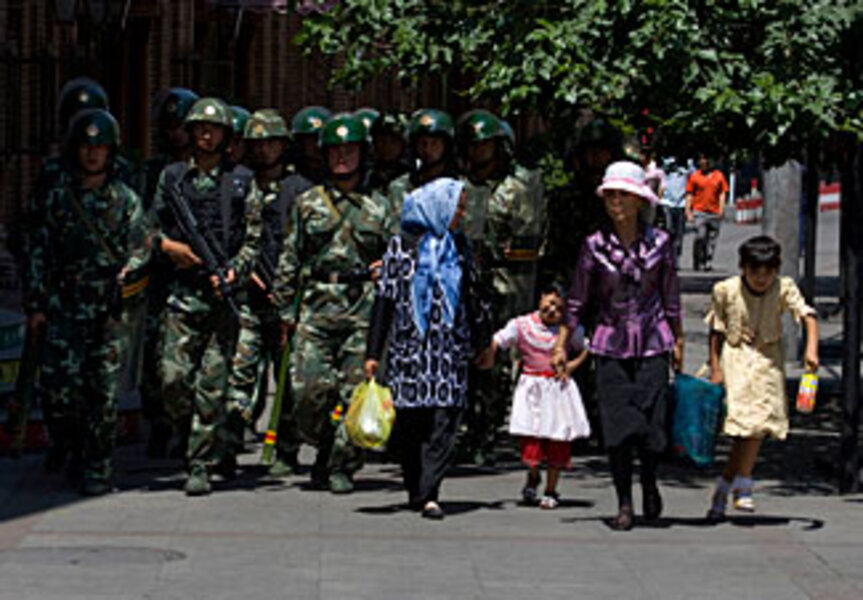Urumqi unrest: China's savvier media strategy
| Beijing
Chinese riot police arrested several Uighurs Friday after breaking up a small demonstration in Urumqi, the capital of China's western Xinjiang Province and the scene of a riot Sunday that killed 156 people and injured more than 1,000.
Authorities arranged extra bus services out of Urumqi after China's worst ethnic violence in decades, but demand outstripped supply Friday as thousands of people poured into bus and train stations to flee the violence-wracked city.
Still, Chinese police this week succeeded in averting a major interethnic bloodbath after initially failing to control Sunday's riot.
Similarly, on the Internet, over the airwaves, and in the written media, Chinese propaganda officials utilized new and more sophisticated tactics to overcome early impressions that the authorities were to blame for the carnage and to paint a more nuanced picture.
"Officials are certainly studying the media-management techniques that are practiced elsewhere in the world," says Rebecca Mackinnon, an expert on the Chinese media at Hong Kong University. "And they actually don't work too badly."
A combination of censoring the Internet, providing Chinese readers with a wealth of reportage (however one-sided), and allowing foreign reporters to work on the ground represents a new Chinese model for handling the media, says Ms. Mackinnon.
"We've moved out of the realm of trying to control everything," she says, "and into a more subtle realm of manipulation and spin."
How Beijing changed tactics since 2008 Tibet unrest
Eighteen months ago, when unrest broke out among Tibetans, the government banned foreign reporters from a huge swath of Tibetan-inhabited western China. Denied the chance to offer firsthand accounts of events, most Western media relied heavily on exile Tibetan sources.
The result was an unmitigated international public relations disaster for Beijing, although at home few Chinese questioned the official version that the Dalai Lama had instigated the trouble that left 18 ethnic Han and Hui Chinese dead.
Last Monday, in contrast, after a demonstration by Uighur protesters had spun out of control, the government invited foreign journalists to visit Urumqi to report for themselves on what had happened. A press center was put at their disposal, and tours of the violence-stricken quarters of the city were provided.
The initial assumption among most Western observers was that most of the dead must have been Uighur demonstrators, cut down by police gunfire. Although the authorities have not given an ethnic breakdown of the victims, reporters interviewing eyewitnesses began to suspect that in fact the majority of the dead may well have been Han Chinese, killed by Uighur rioters.
"We are certainly seeing a more varied and nuanced set of reports out of Xinjiang than we saw about Tibet," says Ms. Mackinnon.
Blocking search terms on the Web
Chinese news consumers, meanwhile, both on the Web and at the newsstands, were treated to a steady and unvaried drumbeat of official reports blaming the violence on Uighur exiles, with nary a mention of the economic and social grievances that have been fueling Uighur discontent for years.
Internet portals were ordered by the propaganda department to fix their search engines so that searches for phrases such as "Xinjiang Uighur dogs riot" or "Politburo silence" or "Beijing, assimilation policy" would yield no results, according to a "blacklist" leaked by a search engine technician.
Bulletin boards – often the site of lively debate on the Chinese Internet but which are required to censor their content – either deleted all posts related to Xinjiang or allowed through only those ones conforming to government policy. The only video visible was from official TV stations. Twitter and YouTube were blocked.
The approach appeared to mark a further step in Beijing's efforts to manage the news more subtly, taking a page from the Western public relations playbook and getting ahead of the news so as to spin it, rather than impose a total blackout.
Internet censorship ensured that there was virtually no independent commentary or reporting of the news, but blanket coverage in official sources (all that Internet portals were allowed to carry), such as the state news agency Xinhua and the state-run China Central Television, gave average Chinese citizen enough news to satisfy them.
Why one Chinese editor disavowed the Wall Street Journal
Foreign reporters were allowed to travel around Urumqi and interview local people, which gave rise to a number of stories sympathetic to Han victims of Sunday's riot, and those articles that raised questions about the official account came in for heavy criticism in the official Chinese press.
"As of today I will no longer be a reader of the Wall Street Journal," senior editor Ding Gang wrote Friday in the "Global Times," a tabloid belonging to the ruling Communist party. "In reporting the Xinjiang riot, the paper stood publicly at the side of the terrorists and became their representative," he charged.
Follow us on Twitter.





